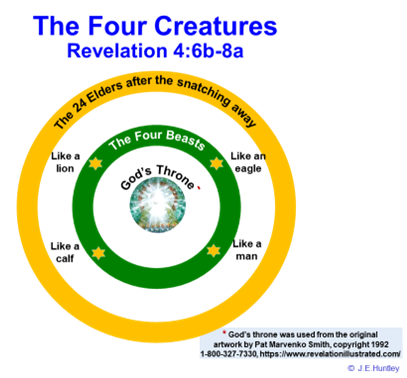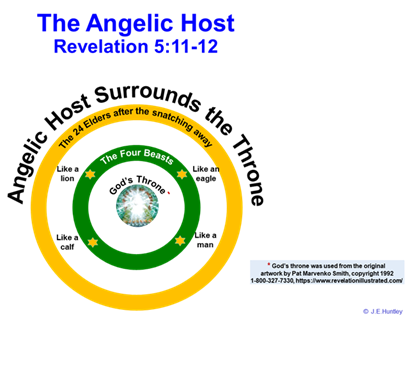Revelation: Chapter 5
Setting
As seen in the chronology of Revelation, John is viewing these events of this chapter from the perspective of heaven. Described on that web page are several events that will occur following the church's snatching away (rapture) but before the tribulation's beginning. This is the pre-tribulation period.
John reported on the outstanding experience he witnessed in the throne room of God; all the noise of praise to Him, Revelation 4:8-11, led by the four beasts, who initiated the praise. This was followed by the 24 elders praising God by falling on their faces and casting their crowns before God’s throne. Then they cry out loudly in praise to God the Father who is worthy of glory, honor, and power because He:
- He created all things
- for His pleasure, they were created
But in all that John has reported so far, where is Jesus? Luke wrote that He was at the right hand of God, Acts 2:33, Peter wrote the same, 1Peter 3:22. Paul too wrote that Jesus was at the right hand of God as well, Romans 8:34. Even David prophesied about a millennia earlier that this would happen, Psalm 110:1. Revelation 4 described the heavenly scene and worship of God the Father, and Revelation 5 introduces Christ Jesus. The events in this chapter describe the great glory of Jesus Christ that is bestowed upon Him by the Father and the response of all creation.
| Verses | Topic |
|---|---|
| 1-3 | The BOOK in the hand of the Father |
| 4-5 | The Lion of Judah |
| 6-7 | The slain Lamb |
| 8-10 | The song of the four creatures and 24 elders |
| 11-14 | All the creation sings blessings to the Lamb |
In Revelation 5:1, after describing the awesome view of the throne of God with all the activities surrounding it, John's attention is drawn to the Father on His throne. God-the-Father has in His right hand a scroll with writing on both sides. At this time, John is a witness to all of these great sights, as they were revealed to him by the angel sent by the Lord, Revelation 1:1. The scroll itself was a normal manner of recording and preserving information in John’s Day; bound books were not used for another century. The information on this scroll is complete, so God sealed it with seven seals.
This scroll was sealed for several reasons:
- For disclosure of information directed to a specified group at a future time, Daniel 12:1-4
- God used the allegory of the scroll to demonstrate the blindness of Israel to His word and for judgment, Isaiah 29:9-13
- To identify officially recognized documents, which in this case are the deed and title to Earth
- The Lord used Jeremiah’s purchase of a parcel of land to show Judah they would return to the land, Jeremiah 32:6-12, Psalms 2:2-9, Matthew 21:33-46
Just as the Lord kept the mystery of Christ secret since the beginning of time until Paul received it from Him, God intends to show His manifold wisdom through the church to the rulers and authorities in heavenly realms, Ephesians 3:9-11. Similarly, this sealed scroll is the Father's deed to earth and all it contains, Psalms 2:2-9, Matthew 21:33-46. Handing the scroll to the Son is when the Father gives dominion to the Son, as seen in Daniel 7:13-14.
As John will observe and report in this book, each seal leads to the conclusion of God's wrath upon the world, which results in the end of man's willful submission to the seductive wiles of Satan at the end of the tribulation. Satan's seduction against man began in the Garden of Eden with Adam, and from that point forward, man lost his dominion over this earth that the Lord had given him, Genesis 1:27-30, Genesis 3:1-10. Examples of Satan, the usurper of this world, are:
- To those whom you obey, you are servants to, Romans 6:15-18
- Jesus did not question the authority of Satan over the kingdoms of this world when Satan offered them to Jesus if He would bow down and worship Satan. Instead, Jesus rebuked Satan because all worship belongs to the Lord our God, and we are to serve Him only, Matthew 4:1-2, 8-11
- Satan is the prince of this world, John 14:30-31, Ephesians 2:2. At the time of his judgments, he will be driven out of this world, John 12:27-31, Revelation 20:1-3, and ultimately thrown into the lake of fire, Revelation 20:7-10
As each of the first six seals is opened, they will reveal (they are not judgments from God) the work of Satan, and the culmination of his sinful nature and their impact on mankind and this world during the seven years of tribulation, as seen in Revelation 7 and other later chapters. The opening of these seals parallels the many examples of God's judgments upon His people and other nations due to sin and their rebellion, similar to what Isaiah wrote concerning the consequences of Judah’s and Jerusalem’s sins, Isaiah 29:1-24. These revelations encompass three general events:
- The first six seals provide evidence of the sins, disobedience, rebellion, and utter contempt of God by Satan and his followers and upon those whom he blinded, 2Corinthians 4:4
- The seventh seal reveals the beginning of God’s severe judgments as a result, which are the seven trumpets, Revelation 8:1-2
- The seventh trumpet introduces the final, and most severe of God’s wrath upon the world, the seven bowl judgments, Revelation 11:15, 19, 15:1, 5-8
These judgements parallel many that God visited upon His people, Israel. Still, in the tribulation, these trumpet and bowl judgments will be upon the nations and the rebellious Jews as a result of sin and their persistent rebellion. This will be similar to God’s warning against Israel, Isaiah 29:1-13
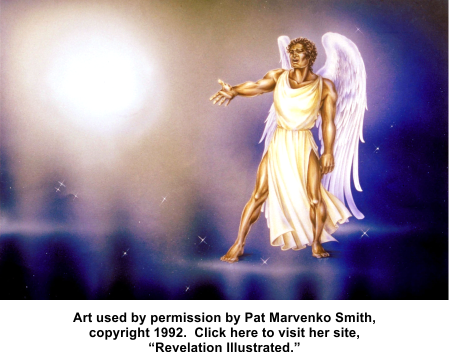 In Revelation 5:2, John observes a mighty angel, the first of many in the book of Revelation, who asks, “Who is worthy to break the seals and open the scroll?”. Some interpret later appearances of mighty angels as Christ, but this is unlikely, as in each case, they may exhibit the qualities of Christ, but only because they are in His presence. To this point in John’s narrative, nothing more is given concerning the scroll in the hand of God the Father. Only its physical attributes are reported. But the following proclamation reveals the importance of this book, Revelation 5:2:
In Revelation 5:2, John observes a mighty angel, the first of many in the book of Revelation, who asks, “Who is worthy to break the seals and open the scroll?”. Some interpret later appearances of mighty angels as Christ, but this is unlikely, as in each case, they may exhibit the qualities of Christ, but only because they are in His presence. To this point in John’s narrative, nothing more is given concerning the scroll in the hand of God the Father. Only its physical attributes are reported. But the following proclamation reveals the importance of this book, Revelation 5:2:
- It is noteworthy that this strong angel is attributed with strength, and not an ordinary angel
- As already seen in Revelation 4, there is order in God’s throne room, and all have a precise role given to them, such as the four beasts with six wings and covered with eyes
- This strong angel is one of many that will be revealed in this book by John, and they will have particular roles and characteristics
- This strong angel has a loud voice to proclaim, “Who is worthy to open the book and loose its seals?”
The proclamation was made to all mankind, from the past (the dead) to the present (the living), asking who is worthy to open the book. No man was found in heaven, on earth, or beneath the world to break the seals and look inside the scroll. Notice that a man was sought. No other creature in heaven or earth was sought. Of all God’s creation, only man was made in God’s image, and God’s plan of salvation for fallen man was Himself; by God’s grace, through faith, Ephesians 2:8-9, believing in His Son’s blood to redeem mankind from all sin, that He was buried, and rose from the dead, 1Corinthians 15:1-4, for our justification, Romans 4:24-25, if they believe in Him and confess that belief, Romans 10:9-10. Who is Jesus? He is God and man, who took our punishment, 1John 4:10, so we could live in Him, and He in us, John 17:21-23.
In Revelation 5:3, note that the proclamation was not “who wants” or “who is willing” to open the book. No man or woman can approach God by their own will or merits. Only through Christ’s death are we reconciled with God, to be presented before God holy, blameless, and above reproach, Colossians 1:21-22. Yet, even with this standing, no one who believes in Christ Jesus is worthy to take the scroll and open it. The search for a worthy person was made in heaven (those with regenerated bodies and those still waiting for their eternal bodies), on earth (living beings), and under the earth (hell). Still, no one living or dead was found worthy.
In Revelation 5:4, John wept greatly when no one was found worthy to take the scroll and break the seals to open it. John was significantly invested in his people, Israel, and the coming kingdom. The heavenly scene, being in God’s presence, completely overwhelmed him, and his emotional discipline vanished. The search for one worthy of such a task was not among any in God's creation, but those in the line of Adam. Though not explicitly revealed concerning John's reaction, recall the disciples' question before Christ's ascension in the clouds to the Father, Acts 1:6-9. The apostles had high expectations that the kingdom would come in their lifetime, Acts 1:6-9. John and Peter proclaimed that the kingdom of heaven was at hand, the day of refreshing and restitution, Acts 3:19-21. As long as this book remained sealed, the judgment upon Israel would continue, and the promise of His return would not happen. They asked when the kingdom would be restored to Israel, the age of peace and restoration. The Lord responded that it was not for them to know the times or the seasons; the Father reserved it as to when He would reveal that information, Acts 1:7-9. So, until that time, and as long as this book remained sealed, the judgment upon Israel would continue. However, once the tribulation begins, the emphasis will be upon Israel since the church will have been snatched away (raptured) and the church will appear before the throne, as seen in Revelation 4:1-11. Additionally, John wrote letters to seven churches to prepare them for the tribulation, Revelation 2-3. He knew from the prophetic books, such as Daniel 7, 9-12, that Israel would go through the tribulation, then the kingdom would come, just as Jesus told them of the great tribulation to come, Matthew 24:15-22.
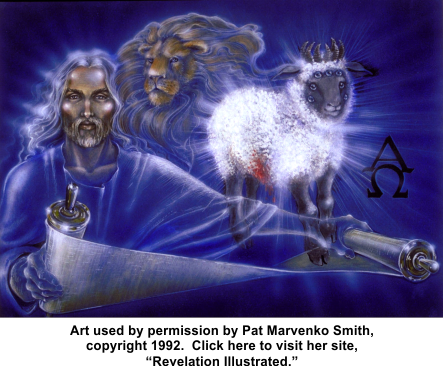 In Revelation 5:5, John is comforted by one of the 24 elders before the throne of God, not the angel assigned by God to reveal these things to John, Revelation 1:1. The elder, who represents the church as discussed in Revelation 4:1-11, comes to John, encouraging him, saying that John should not weep, and shows him the reason why. John earlier saw the glorified Christ among the churches in Revelation 1:13-18. Now John is shown Christ Jesus by the elder, who, like John, was also redeemed by the blood of the Lamb, and could point to Christ, as the:
In Revelation 5:5, John is comforted by one of the 24 elders before the throne of God, not the angel assigned by God to reveal these things to John, Revelation 1:1. The elder, who represents the church as discussed in Revelation 4:1-11, comes to John, encouraging him, saying that John should not weep, and shows him the reason why. John earlier saw the glorified Christ among the churches in Revelation 1:13-18. Now John is shown Christ Jesus by the elder, who, like John, was also redeemed by the blood of the Lamb, and could point to Christ, as the:
- Lion of the tribe of Judah, to rule and reign over Israel, Genesis 49:8-10, Hosea 5:14-15
- Root of David, King of Israel, 2Samuel 7:12-13, 16
Christ Jesus is the one who prevailed at the cross, and can receive the book from God the Father, loose its seven seals and open the book, Psalm 8:5-6, Hebrews 2:7-9. From the elder’s perspective, who already experienced the “Day of Jesus Christ,” which included the snatching away (rapture), views the Lord’s next big event, which is the Lord’s literal, physical, visible, earthly return to sit on David’s throne. The Lord Jesus is the Lion of the tribe of Judah, fulfilling prophecy. Jacob prophesied on his deathbed over his son Judah, Genesis 49:8-10, that the scepter would never depart from his tribe, Ezekiel 21:25-27. Christ Jesus, the Lion of Judah, would rule and reign over Israel and the world. He is also the slain Lamb who is the foundation of the gospel of Jesus Christ; He died according to scripture, then He was buried, and on the third day He rose from the dead according to scripture, John 1:29-31, and 1Corinthians 15:1-4.
The elder also tells John why the Lord Jesus is the only one worthy, who, as the root of David, has triumphed, Isaiah 11:1-5, Isaiah 11:10-11, Romans 15:8-12. Christ Jesus is the one who prevailed at the cross and as the slain Lamb, He alone can open the book and loose its seven seals, Psalm 8:5, Hebrews 2:7-9. From this point on, the focus shifts from the Lord as the Lion of Judah to Christ as the slain Lamb. As John Phillips points out in his commentary on Revelation, Christ Jesus is only referred directly as the Lamb two times in the Old Testament, Isaiah 53:7 and Jeremiah 11:19; only twice in the gospels, John 1:29, 36; once in Acts 8:32; once in the epistles, 1Peter 1:19, but 28 times in Revelation. He went on to write that the emphasis on Jesus and His work on the cross is clear:
- As the slain Lamb, He drew all men to Himself, John 12:31-50
- The Lamb’s seven horns demonstrate the omnipotence of the Lord
- The Lamb’s seven eyes demonstrate the omniscience of the Lord (These are the seven characteristics of the Holy Spirit, Isaiah 11:2)
The Kinsman Redeemer
In Revelation 5:6a, the Lord Jesus Christ is the only one to break the seals and reveal their contents. He can also serve as the kinsman redeemer to Israel and the Gentiles. For Israel, He will redeem the land, judge and eject the usurper (as done on the day of Jubilee, Leviticus 25:9-10), and return them to it. For the Gentiles, He takes the Body-of-Christ as His bride. The day of Jubilee is announced on the feast of atonement, and is why John sees the Lord as a lamb slain, Leviticus 25:9-15. Redemption (atonement) comes before restoration (Jubilee). He is Emmanuel, Christ with us, Matthew 1:23, and therefore He is our kinsman. Most importantly, Jesus alone paid the price in full for our redemption from the wages of sin and by His shed blood on the cross, He made reconciliation to Himself, all things in heaven and earth, Colossians 1:20. Christ Jesus is in the center of all things, for it pleased the Father that in Jesus all the fullness should dwell, Colossians 1:19. He is the only person born in this world who could serve the position of Kinsman Redeemer, Ruth 3:12-13, John 14:6-7, since He:
- Was born a Jew, a near kinsman, Romans 9:4-5
- Was the only one who lived and was without sin, 2Corinthians 5:21
- Was the only one whose shed blood could redeem Israel and Gentiles from their sins and release them from its bondage, Hebrews 9:11-15
- As the kinsman redeemer, Boaz could restore the land lost to Naomi, Ruth 4:5
- As the kinsman redeemer, He takes revenge upon the usurper. Israel will then return to their land in peace, and enjoy the promises of God to them in the kingdom dispensation
- As the kinsman redeemer, Boaz could take Ruth to become a Gentile bride, Ruth 4:5
Finally, this event ties directly to a part of the Mosaic Law described in scripture as the kinsman redeemer, Leviticus 25:23-28, Leviticus 25:47-49, Numbers 35:19-21, Deuteronomy 25:5-10, as described in the book of Ruth 2:20, and illustrated in Jeremiah 32:1-44 before the final fall of Jerusalem to King Nebuchadnezzar. There are three parts to being a kinsman redeemer. First, as a near kin to the person needing help, he redeems the family member from bondage, just as the Lord Jesus redeemed all mankind from the bondage of sin by His shed blood on the cross. Second, he redeems the land back from the land brokers, just as Jesus Christ does, by taking the sealed scroll from the hand of the Father, being the only one found worthy to do so. Finally, the kinsman redeemer avenges against the usurpers who took the land. As a result, the family members can regain possession of the land and enjoy the promises of God to them. In this case, the Lord will pour out His wrath upon the world to the final battle of Armageddon, when Satan and all his forces are defeated and removed from the earth, the Lord, as the kinsman redeemer, establishes his first 1,000 years of His eternal reign over this world. He restores the land to Israel and God's original design.
From the book of Ruth, Boaz, a kinsman, was able to secure the land lost to Naomi. She represented Israel and was the mother-in-law of Ruth, a Gentile. Boaz then took Ruth, a Gentile, to be his wife. Ruth was identified to Boas, who represents the Lord in this story, by a nameless servant, who represents the Holy Spirit. This account of God's grace to Israel and the Gentiles is similar to a much earlier time when Abraham had his servant find a bride for his son, Isaac, Genesis 24:1-67.
Similarly, Jeremiah was commanded by the Lord to buy a parcel of land from his uncle during the impending and certain fall of Jerusalem, Jeremiah 32:6-15. The Lord used this law of the kinsman redeemer to show that the houses, fields, and vineyards would again be possessed by Israel. Still, the symbology of Jeremiah placing the document in a clay jar to preserve it for a long time means Israel must also wait a long time to reclaim her land. Jeremiah then prayed to the Lord, expressing not only God's greatness, grace, and long-suffering, but also the rebellion of Israel against all that God commanded them to continue in. He then closes, asking for the meaning of the act as a kinsman redeemer, the Lord instructed him to perform for his uncle, Jeremiah 32:16-25. The Lord's response is twofold: First, He reminds Jeremiah of the evils done by the Jews and Israel, and hence the judgment of removing them from the land. Second, the Lord will return them to the land as their kinsmen redeemer so that Israel will enjoy the new unconditional covenant the Lord made with them. They will again buy their lands, and all their fortunes will be restored to them by the Lord, Jeremiah 32:26-44. This restoration occurs when the Lord establishes His millennial reign over the world, centered in Jerusalem, following the seven years of tribulation.
The website, Jesus Plus Nothing, provides an excellent summation on the kinsman redeemer and the four things the kinsman redeemer accomplished.
Further in Revelation 5:6b, John observes the Lord as a Lamb slain, the figure of Christ's sacrifice on the cross to give His shed blood for our ransom from the judgment of sin. The Lord is both a king and servant, Isaiah 53:5-7, John 1:29. There are several attributes to the Lamb:
- The location of the Lamb is at the center of God's throne, where the trinity is revealed
- The Lamb has seven horns indicative of complete power
- He is encircled by the four creatures and the 24 elders
- He has seven eyes which depict complete knowledge, Psalms 66:7, Proverbs 15:3
- In Christ Jesus dwells all the fullness of the Godhead bodily, Colossians 2:6-9
- The seven eyes are the seven spirits of God sent into all the earth, Isaiah 11:1-2, John 16:13-15, Zechariah 4:2, 6, 8-10
- The Spirit of the Lord
- The Spirit of Wisdom
- The Spirit of Understanding
- The Spirit of Counsel
- The Spirit of Power
- The Spirit of Knowledge
- The Spirit of the fear of the Lord
Revelation 5:7 is about the Lord Jesus, seen as the slain Lamb who was worthy to take the scroll, the seven-sealed scroll, out of the hand of God the Father. This scene points to Christ as the one who is the complete fulfillment of all the prophecies concerning Him to establish His kingdom on earth, sitting on the throne of David, Revelation 5:6-7.
- After His ascension, He sat at the right hand of the throne of God, Psalms 110:1, Hebrews 1:13
- As the Lion of Judah, He would rule and reign over Israel, Genesis 49:8-10, John 5:26-27
- As the slain Lamb, He would draw all men to Himself, John 12:31-50
In Revelation 5:8-10, the scene concerning the four creatures and 24 elders changes slightly in that the elders do not respond to the worship of the beasts; instead:
- Both groups fall together before the Lamb
- Each one of them possesses a harp
- Every one of them held golden bowls full of incense, which are the prayers of the saints, Psalms 141:1-2
- There is an implied association or expectation of fulfillment of the prayers of the saints with the dominion being given to the Son, since these prayers are remembered and presented at this time
John hears a new song sung in response to the Lamb receiving the scroll to inaugurate His kingdom on earth, Psalms 144:5-10, Mark 10:42-45, 1Corinthians 6:19-20. This chorus of exaltation continues with the status that they now have because of the Lord Jesus Christ, who shed His blood on the cross to redeem all mankind who believe in Him and confess His name. As Peter wrote to the believers in Israel, the Lord made them a kingdom and priests, 1Peter 2:4-5, 9-10, Revelation 5:10, Revelation 20:4. Imagine being John and observing all these wondrous sights and sounds. One can only imagine the deafening sound of joy, excitement, and sold-out admiration of the Father and the Lord Jesus Christ. There could be no comparison to anything we, in our physical state, could ever approach such an excellent experience. Notice, too, that the four creatures and the 24 elders sing that by His blood, the Lord purchased men for God from every tribe and language and people and nation. As mentioned earlier, the Lord is our kinsman redeemer! As a result, He has restored Israel to their land and made them a kingdom and priests to serve God, and they will reign on earth (during the millennial reign of Christ). And the Lord married the Body-of-Christ. They both are one in Christ, represented as the 24 elders, who sing:
It is apparent from this first song by the 24 elders that they are directly affiliated with those on earth, since they speak of being redeemed by Christ Jesus. He did this for all mankind, not the angels or other heavenly beings. This had to have been an incredible, deafening experience for John that would bring chills down one’s spine. It does not say, but it may be that John also joined in singing praises to our Lord. Who couldn’t resist?
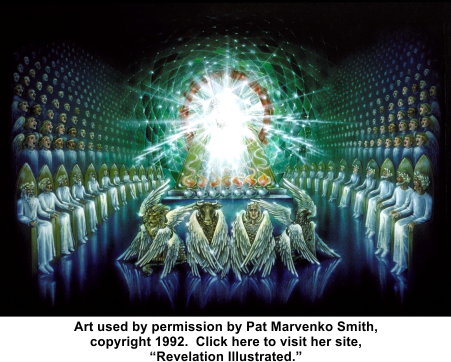 In Revelation 5:11-12, the singing progresses, including the angelic host around the throne. John notes their number to be one hundred million strong, plus additional thousands upon thousands, but who’s counting! With thunderous joy, they all give praise, honor, and glory to our Lord Jesus Christ, Revelation 5:11-12. The activity about the throne described by John is very similar to what Daniel wrote when he viewed the throne area. Daniel's account is congruent with what the Apostle John wrote.
In Revelation 5:11-12, the singing progresses, including the angelic host around the throne. John notes their number to be one hundred million strong, plus additional thousands upon thousands, but who’s counting! With thunderous joy, they all give praise, honor, and glory to our Lord Jesus Christ, Revelation 5:11-12. The activity about the throne described by John is very similar to what Daniel wrote when he viewed the throne area. Daniel's account is congruent with what the Apostle John wrote.
As with Daniel, John reports many angels that encircle the four creatures, 24 elders, and the throne. These numbers are associated with angels (thousands upon thousands), but it is not certain that the ten thousand times ten thousand are angels, but maybe the church, Hebrews 12:18-24.
In Daniel 7:9-14, Daniel reported on the appearance of God's throne room just before the beginning of the tribulation to judge the indescribable beast. What is missing from the previous visions concerning God's throne by Moses, Ezekiel, and Isaiah? Daniel mentions two groups: those who attended the Lord (thousands upon thousands) and those who stood before Him (ten thousand times ten thousand). The number 100,000,000 may indicate an extraordinary number of those raptured and those who are the bride of Christ and their proximity to God before the throne. Daniel saw a court seated before the throne of God and books of judgment opened, Revelation 20:12, before the Lord who judges all, John 5:22-23.
It is contended that Daniel 7:13-14 provides details of the events surrounding the throne of God that directly relate to the events as they unfold in Revelation 5:1-14.
Following the singing of the four creatures and the 24 elders, John now hears the response of the angels in song:
The singing progresses, including the angelic host around the throne. With thunderous joy, they all give praise, honor, and glory to our Lord Jesus Christ. The following graphic shows the expanding symmetry in God’s throne room.
In Revelation 5:12, John hears all of the saints continue praising God, and the angels sing and loudly shout. There are several elements in this praise to the Lord:
- Power
- Riches
- Wisdom
- Strength
- Honor
- Glory
- Blessing
Notice seven elements in this praise to the Lord: the number of completeness.
In Revelation 5:13, the whole creation joins in the song:
Now is the finale of all those praising our Lord Jesus Christ. However, this time, as the united voices climb to a crescendo, every creature that is in heaven, earth, and hell, including those in the sea, everyone joins in the chorus, Revelation 5:13-14.
This would harken back during the creation, before man, when Lucifer was involved with music in heaven, as suggested in the KJV, Ezekiel 28:13. He was the model of perfection before his fall, and likely the highest of all angels, Ezekiel 28:12b, the covering cherub, Ezekiel 28:16.
There is no exclusion of believers only; all are included, believers and unbelievers. Every creature, including Satan, since Christ Jesus was the one who created all creation, and all creation will join in the praise of the Lamb, Colossians 1:16-17,
Then, in the final act of praise, Revelation 5:14, the four living creatures conclude the singing and say, "Amen," and the elders fall and worship God.

